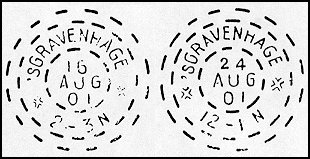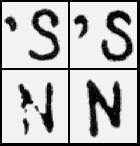

![]()
| "Vulcanus" This is a description of one of the most odd postmarks ever used in the world: The Dutch cancellation machine "Vulcanus" used in 's-Gravenhage in 1901. 's-Gravenhage (or 's Hage or Den Haag) is the Dutch name for The Hague and is a town on the sea side of The Netherlands. 's-Gravenhage means the Count's hedge. Latin: Haga Comitis. Around 1900 the Dutch PTT asked an engineer from The Hague, Mr. C. C. van der Valk to construct a machine with a postmark that could burn an impression in the stamps on postcard and on the envelope without damaging the content of the letter1. In one year C. C. van der Valk had made a useful machine that worked with a red heat postmark. As electricity was not commen at the post offices at that time C. C. van der Valk used a kerosen flame to heat the postmark. The kerosen reservoir was placed above and away form the machine and the flame was fed by the kerosene through a thin pipe. On 3 August 1901 the brandstempel-machine Vulcanus was installed in the 's-Gravenhage post office2 - see photo - and the first known oblitartion is from 5 August 19013 from the day when the machine was tested. The machine was taken in regular use from 6th August 19014. |
 The "Vulcanus" brandstempel-machine. |
![]()
| As one can imagine there were serious problems with the machine as it not only burnt an impression in the stamps but sometimes also destroyed the content of the letters! The trial period for the use on letters ended on 29 September 1901 but it was used for postcards and printed matters until 2 November 19015.
From the photo you can see that the machine was operated by a pedal and a skilled postman could obliterate as many as 240 letters/postcards per minute and a not trained person could obliterate about 100 per minute. The machine used only one litre of kerosene every five and a half hours and the price was 1.5 cent per hour for the kerosene5. Two postmarks were in use in the trial period for the machine: |
 The two postmarks - Type I and II5. |
 Type I and II. |
![]()
| Below a postcard postmarked with the type II postmark from 's-Gravenhage on 19 August 1901. The postage fee for an inland postcard was 1 cent in the period 1871.01.01-1919.11.016. The "D 214" cancel is a so-called mailman cancel. In this case it referred to a mailman in Amsterdam whose badge number was "214". The "D" tells us which delivery of the day it was. At one time Amsterdam had nine deliveries a day (!). The first delivery in the morning was the "A"
delivery, the second one the "D" delivery, and so on. The "D" then signifies
that it was the 4th delivery of the day and the card was put in the
receiver's mailbox by mailman No. 214.6
According to Erik Jensen from the Danish Post- & Telemuseum C. C. van der Valk offered his Vulcanus to the Danish General Post Office on 30 April 1901. As Erik Jensen write in his article: The machine was hot news at that time but to the pleasure for the future stamp collectors, the Danish GPO did not accept Mr. van der Valk's offer! 7
References: Acknowledgements: |
![]()
Uploaded 19.02.2001 - updated 03.10.2010
© 2001-2010 by Toke Nørby